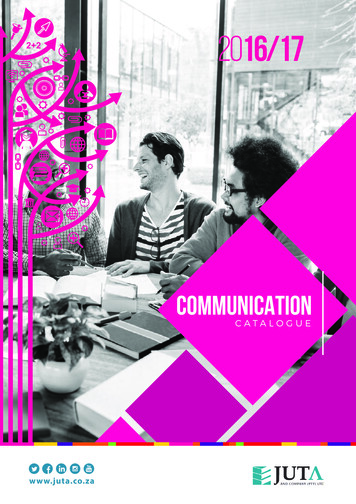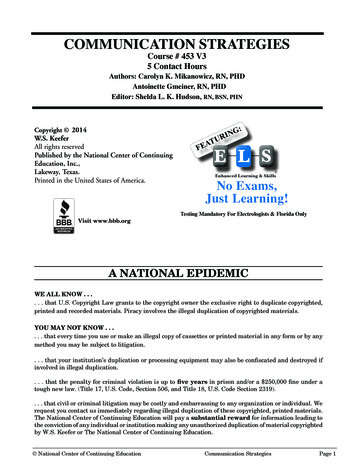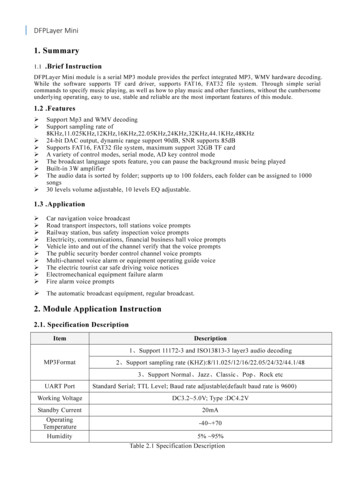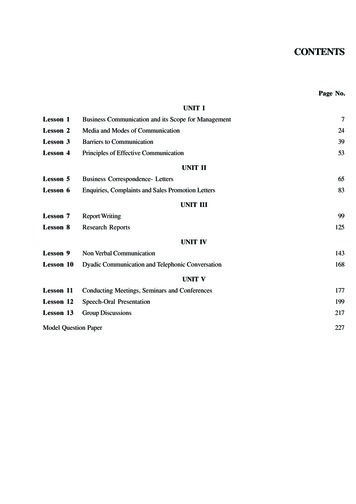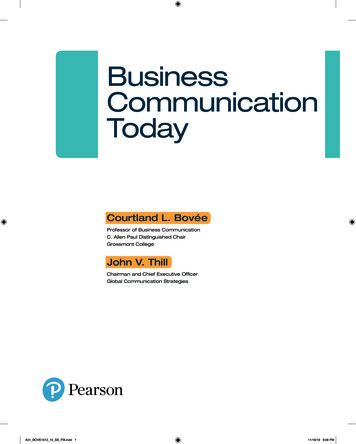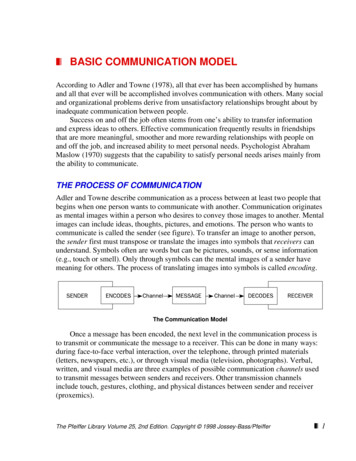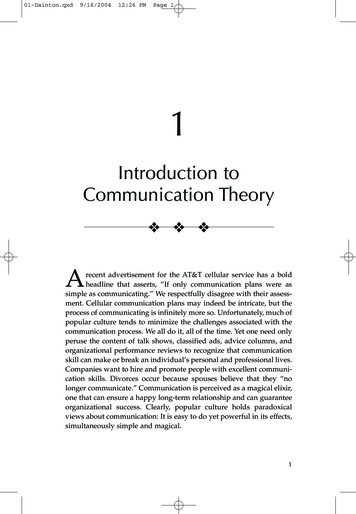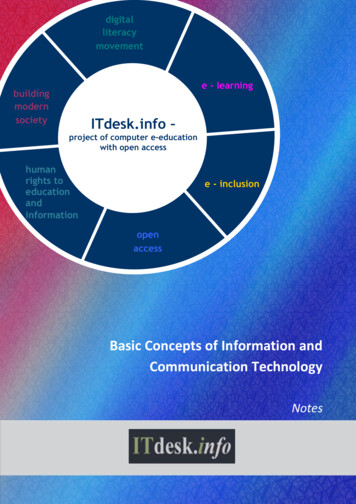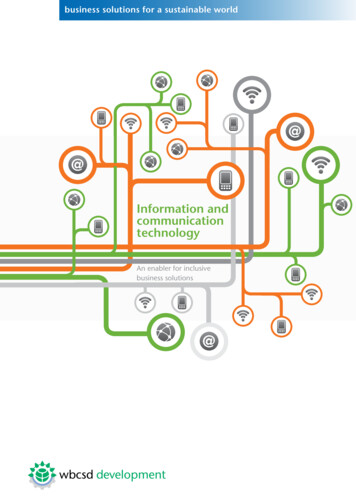
Transcription
business solutions for a sustainable worldInformation andcommunicationtechnologyAn enabler for inclusivebusiness solutions
Table of contentsThe growth story of ICT2The nexus between ICT and development2Examples of ICT-enabled solutions3Benefits and lessons learned10WBCSD Technology Enablers Initiative11Notes and references12
The growth story of ICTNot long ago access to information and communicationtechnology (ICT) was the privilege of a small minority ofthe world’s population. ICT has undoubtedly transformedthe way we live in the developed world: computers arenow found on every office desk, and high-speed internetand mobile phones have changed the way in which wecommunicate, work, shop, and socialize.Since the turn of the century, ICT has transformed thedeveloping world, too. Whilst in 2000 more than half ofmobile phone users were in the developed world, thebalance started shifting around 2005, and in 2011 aboutthree in four users were based in the developing world (seeFigure 1). Today, the largest mobile phone company (bynumber of subscribers) is China Mobile, with over 600 millioncustomers.However, not all technologies and services have developed atthe same pace. Fixed-line telephony and broadband internetsubscriptions, for example, have evolved more slowly thanmobile phone use in developing countries (see Figure 2).Some concerns have also been raised that the poorestcountries may be left behind and that a “digital divide” maybe growing. Yet the latest figures from Africa, the world’spoorest continent, are encouraging, in particular with regardto mobile phone connections, which reached over 620million as of September 20111.This is an important sign, as investment and innovationto boost mobile penetration have an impact on economicgrowth. For instance, Indian states with 10% higher mobilephone penetration see annual growth rates of 1.2% higherthan states with a lower mobile phone density2.The nexus between ICT anddevelopmentICT can expand the breadth and depth of economic activityin developing economies and improve the delivery of a rangeof essential public services. Governments of developingcountries are therefore making significant investments in theinfrastructure supporting ICT services. For instance, threesubmarine data cables have been installed off the coastof Africa in 2011, a huge investment that has quadrupledmobile data speeds and cut prices by 90% in connectedcountries6. For its part, Kenya aims to accelerate socioeconomic development by becoming a global ICT hub7.In some cases, ICT can help developing countries “leapfrog”traditional development stages. For example, the spread ofmobile phones has allowed developing countries to rapidlybuild a modern communication infrastructure without theneed to install vast grids of fixed phone lines.Investment in ICT alone is not enough, though. While there isa strong link between access to ICT and development, it is nota panacea, but rather a powerful tool to tackle velopedDevelopedDevelopingFigure 1Mobile-cellularsubscriptions, by level ofdevelopmentTotal 719 millionTotal 2.2 billionTotal 6 billion2Source: International Telecommunications Union (2011). ICT Data and Statistics.Available: www.itu.int/ITU-D/ict/statistics/ Last accessed 1 December 2011.2000Many factors are driving the rapid diffusion of ICT inemerging countries: the appetite of consumers, constantinnovation in the industry, increasing availability of networks,and decreasing costs of hardware and software. In fact,prices for ICT services worldwide are falling while services aregrowing, though at different rates: fixed broadband servicesshowed the largest price decline (42% between 2008 and2009), followed by mobile cellular services (25%)4. Thatbeing said, people in developing countries still have to spendrelatively more of their income (17.5%) on ICT services thanpeople in developed countries (1.5%)5.
challenges. Both access to ICT and the way in which technologyis used have an impact on development. Solutions must beadapted to the local context and support services available. Forinstance, providing computers to schools in remote areas doesnot necessarily foster education. Success depends on a broaderset of factors including reliable and affordable electricity power,maintenance support, and teachers8.Examples of ICT-enabled solutionsMarket experience shows that access to technology drivesprivate sector activity and innovation by local entrepreneursand SMEs. In turn, this opens up new market opportunitiesand helps to better fulfill the daily needs of customers.Moreover, technology increases the potential for largercompanies to connect with the poor by increasing the scaleand profitability of their investment. This creates opportunitiesnot just for large technology service providers, but also forcompanies in other sectors that serve the poor as consumers,engage low-income entrepreneurs in their supply chains, orwork with governments or other institutions to deliver keypublic goods and services.For companies seeking to implement ICT-enabledventures, the key challenge they face is oftentimes notin the technology in itself, but in finding the appropriatecommercial model, and ensuring that all participants derivesome value. This includes weighing the costs and benefits ofdifferent types of technologies, for example the use of smartphones versus more basic devices.In the following pages, we present a number of case studiesthat highlight the power of ICT-enabled solutions. Manyof these exemplify inclusive business models, i.e. businessventures that engage the poor on the demand side asWhat is ICT?Information and communicationtechnology (ICT) is an umbrellaterm and consists of all technicalmeans used to handle informationand aid communication, includingcomputer and network hardware,communication middleware as wellas necessary software. In other words,it encompasses radio, television, fixedand cellular phones, computers andnetworks, satellite systems and so on,as well as the various services andapplications associated with them.This definition informs our discussionin this report3.clients and customers and on the supply side as employees,producers, and business owners.Table 1 provides some examples of solutions across sectors andalong the value chain. They are a mixture of commercial andmore philanthropic activities using technology. The list shouldnot be seen as exhaustive. As the sector develops further andnew technologies and standards emerge, new opportunities toleverage technology will become available.Per 100 inhabitantsSource: International Telecommunications Union (2011). ICT Data and Statistics.Available: www.itu.int/ITU-D/ict/statistics/ Last accessed 1 December 2011.Global ICT developments, 2001-2011*10090Mobile-cellular telephone subscriptionsInternet usersFixed telephone linesActive mobile-broadband subscriptionsFixed (wired)-broadband subscriptions807060504030Figure 2Global ICT 20072008200920102011** estimate.3
Table 1: Some examples of ICT-enabled solutions across sectors and along the value chainAgricultureHealthRemote data collectionSeed distribution,crop levelsFood availabilityPatient data,medical supplyinventoryEducation & awareness raisingAccess to marketprices, weatherCustomerinformationMedical remindersCommunication andtraining(two-way dialogue)Field agentscapacityCoordination ofdistribution networkHealth workercapacityAnalysis and reportingCrop levelsHunger andmalnutrition analysisPatient complianceanalysisTracking(geographic information)GPS data, plantdiseasesRemote services, incl. last mileand security of information4FoodAutomatic detectionof plant diseases,irrigation needHuman diseases,medicine deliverySupply chainmanagement,tracking foodvouchersPatient diagnostic
EmergencyresponseImpact resultingfrom emergencyWater andenergyBanking ngCriminal intelligencedata, populationsurveys and IDWater quality, treeplantingMarket analysisArrival ofemergency suppliesPopulation alertsCustomerinformationAvailability andusage of onlineeducationalmaterialsAwareness of localevents/issuesAlert andcoordinationsystems, onlinebulletin boardsCustomer serviceCustomized ATMmachinesTeacher training,online educationalcommunitiesElectionparticipation/ resultsThreat- and riskmapping analysisSustainabilityanalysisMobile portfoliomanagementSecurity monitoring,trends analysisDisasterassessments, supplychain managementGeospatial mappingof water sourcesGeo-marketingPeace incidents,security monitoringFamily reunification,job opportunities,fundraisingMeteringMobile banking andpaymentse-government,m-governmentSource: Accenture Development Partnerships (2011)5
Case StudyITC’s farmer empowerment program in IndiaBuilding a more efficient supply chain leveraging the internetITC is one of India’s leading privatecompanies, with annual revenues of USD7 billion and 29,000 employees. It is activein fast moving consumer goods, hotels,paper and packaging, agribusiness, andinformation technology. In India, morethan 50% of the population work in theagricultural sector, which accounts for 14%of the country’s Gross Domestic Product.The sector is relatively underperformingwith fragmented farms, inefficient practices,and poor infrastructure undermining qualityand keeping costs high. ITC’s e-Choupalprogram – run by ITC’s Agri BusinessDivision – has setup internet access kiosksin rural areas to enable farmers to retrievemarketing and agricultural information. Thisin turn helps them take better decisions andpotentially increase their income by betteraligning farm output to market demands.ITC e-Choupal builds on three elements:an internet-enabled computer locatedat a “focal point farmer,” an internetconnection via phone lines or a very-smallaperture terminal (VSAT), and dedicatedservices through the echoupal.comportal. Each internet connection serves10 villages in a 5km radius, reaching 600farmers on average. The portal provides asecure platform using IDs and passwords.Farmers can access information on farmingbest practices, market prices home andabroad, weather forecasts, news, and aQ&A section which enables interactionwith ITC’s agricultural experts. This digitalnetwork is backed by ITC’s large scaleagri extension services in farm practices,watershed development as well as non-farmrural livelihood programs such as livestockdevelopment.In addition to providing farmers with accessto more accurate market information, theportal enables them to manage risks, such assoil contamination or salinity, through accessto technical information. This creates a directmarketing channel for farmers, reducingtheir transaction costs and improvinglogistics. Finally, it provides the link toChoupal Saagars, integrated rural servicecenters serving 40 e-Choupals each, wherefarmers can bring their farm produce to sell,and buy seeds, fertilizer, farming supplies,and consumer goods.Each ITC e-Choupal requires between USD3,000 and USD 6,000 to be set up andapproximately USD 100 per year to bemaintained. The system is free for farmersto use but the “focal point farmer” incursoperating costs and has an obligation toserve the entire community. In turn, the hostfarmer benefits from the prestige of the roleand receives a commission for transactionsthrough the ITC e-Choupal. .The ITC e-Choupals not only serve as a socialgathering place facilitating informationexchange, but also as an e-commerce hubcollecting village orders, hence cuttingdown transaction fees from intermediarieswhen buying or selling goods and reducinglogistics costs. Started as a project to reengineer the procurement process foragricultural products and raise farmerincomes, the initiative has become a highlyprofitable distribution and product designchannel tailored to the needs of rural India.Over the last 12 years, ITC has set up about6,500 access points, benefitting 4 millionfarmers. The continuing innovation in ITCe-Choupal in its version 3.0 is expectedto benefit more than 10 million farmersthrough integrated use of mobile phonesfor more personalized services. ITC is alsopartnering with banks to offer farmers accessto credit, insurance and other services.Furthermore, farmers are beginning tosuggest – and in some cases, demand – thatITC supply new products or services oroffer additional crops, such as onions andpotatoes. Farmers are thus becoming apartner in product innovation for ITC.mKrishiNokia LifeDrishteeCreated by Tata Consultancy Servicesin 2009, this customizable mobileagro advisory system service providesinformation on weather, soil conditions,fertilizer and pesticides, grain pricesand other agriculture-related adviceto farmers in India in local languages.Today, the fee-based service allowsfor growing profits for 10,000 farmersthrough 12 projects across India.Initiative launched in 2008 to addressinformation gaps, delivering targetedservices for healthcare, agriculture,entertainment, and educationinformation via low-cost SMS. Over40 million people have experiencedNokia Life.Social enterprise developing andimplementing a rural supply chainnetwork in rural India. Drishteeestablishes kiosks that offer affordableinternet access, consumer products andcommunity services to rural villages.Local entrepreneurs manage thesekiosks. The network has more than14,000 entrepreneurs registered to dateand kiosks operating in three states.E-connectingN.logueSimilar examples6Gives information and communicationaccess to people in rural areas of Indiaby installing kiosks with a wirelessinternet connection. N-Logue hostsa number of applications that enablequick access to education, healthcare,consultancy and e-governance.Established in 2008 to offer atechnological and communicationsplatform that allows users to exchangedata, money, and information at alow cost through a.o. mobile andconventional phones, the Internet,and automatic teller machines. Thisenables companies, financial and publicentities, and low-income producers andconsumers to increase their productivityand competitiveness.
Case StudySafaricom’s M-PESA mobile money serviceEnabling financial transactions for consumers and businessesVodafone is one of the world’s leadingmobile communications companiesby revenue (USD 71.6 billion in 2011),reaching out to some 390 millioncustomers. Safaricom is Vodafone’s localaffiliate in Kenya. It has approximately12 million customers and revenues ofUSD 1.1 billion per year.In 2007, Safaricom launched M-PESA, anSMS-based money transfer system thatallows customers to transfer and makepayments using a mobile phone. This hastransformed financial services by makingtransactions cheaper, faster and moresecure. The initial pilot, involving some500 customers, was done in partnershipwith the UK Department for InternationalDevelopment, which provided matchingfunds, the Commercial Bank of Africa, andFaulu, a local microfinance organization.Since 2007, the system has expanded toAfghanistan, India, South Africa, Tanzania,Qatar and Fiji, reaching over 30 millioncustomers to date.In order to use the mobile banking service,customers first need to create an accountby simply registering with their ID at anyM-PESA outlet. Users can transfer fundsto other users or to sellers of goods andservices by sending text messages. Theycan also redeem their balance.M-PESA finances itself through userfees. When users deposit cash into theiraccounts, they get credited with “e-floats,”the electronic equivalent of local currency.Depositing money does not incur fees,but users pay whenever they make atransaction: when they send money, orwhen they make a withdrawal. Fees areon a sliding scale – withdrawing USD 100costs USD 1 fee for example.The system is quickly adapting to theneeds of local customers. For instance,in Afghanistan, it includes an interactivevoice system for users who cannot readwhile in Kenya, it has been expanded tointernational money transfers. In Kenya,Safaricom has also partnered with EquityBank to develop an interest-bearingsavings account on mobile phones,enabling customers access to microsavings,microinsurance, and other bankingservices.M-PESA has reduced the barriers tofinancial transactions for consumers andbusinesses alike. In the past, those withoutbank accounts could seldom transfer fundscost-effectively or quickly. Instead, peopleusually paid in cash, often had to travellong distances to make payments, with therisk of losing money or getting it stolen.M-PESA has made paying, receiving, orstoring money much easier for individuals.Businesses are benefiting from its positiveimpact on cash flow, as many haveadopted now adopted M-PESA to offer B2Bservices. For example, suppliers are nowable to collect payments from distributorsvia M-PESA.ANZ Wing mobile bankingSimilar examplesStandard Bank inclusive bankingStandard Bank has developed a mobilemoney account for low-income earnersin South Africa. It builds on mobile phonetechnology and a partnership betweenthe bank and informal retailers (commonlyknown as spaza shops) in townships andrural areas. There is no monthly fee for theaccount, no fee for deposits, and a 1%fee for withdrawals. The bank’s revenuestream comes from small charges ontransfers. Standard Bank is signing upsome 45,000 new clients each monththrough its network of thousands of bankshops, and aims to offer lending andsavings products in the future.Australia and New Zealand BankingGroup Limited (ANZ) Wing providesmobile banking services in Cambodia,enabling rural communities to save,make payments, or transfer moneysecurely and quickly. It has attractedsome 350,000 customers. In late 2011,ANZ sold the Wing company to InterLogistics, parent company of the MobileRefresh payments business.WIZZIT mobile bankingWIZZIT offers over 5 million customersacross a handful of African countries alow-cost bank account that uses mobilephones for making person-to-personpayments, transfers and pre-paidpurchases, and a Maestro debit cardfor making payments in the formalretail environment. The South Africancompany employs a few thousand“Wizzkids” – unemployed people fromlow-income communities – to promotethe product and help unbankedcustomers open accounts.Telefónica mobile bankingIn early 2011, Telefónica andMasterCard launched a joint ventureto implement mobile banking acrossthe 12 Latin American countrieswhere Telefónica operates its Movistarmobile network. The venture providescustomers with mobile paymentservices linked to a mobile wallet orprepaid account. Services includemoney transfers, bill payment, and retailpurchases.7
Case StudySMS for LifeImproving the reliability of malaria prevention and treatment systemsMalaria continues to be a significant healthproblem, especially in sub-Saharan Africa:more than 216 million people are infectedper year and about 655,000 die from it,mostly children under five and pregnantwomen.Effective medicines to treat the diseaseexist. For instance, Novartis, a multinationalhealthcare company, delivers its antimalarialartemisinin-based combination therapy(ACT) Coartem without profit to thepublic sector. Since 2001, the company hasprovided 500 million treatments, impactingmore than one million lives.A key challenge in the fight against malariais to ensure that medicines reach those whomost need them: patients living in remoterural areas with poor access to healthservices. Stock-outs of medicines at thehealth facility level are a big and persistentproblem in many sub-Saharan countries.Once medicines arrive in the country andenter the supply chain, there is little or novisibility on what happens with them. Thismakes it extremely difficult to manage thesupply chain and to anticipate stock-outs.Using short messaging service (SMS) andmobile mapping technology, a publicprivate partnership called “SMS for Life”between Novartis, IBM, Vodafone, the RollBack Malaria Partnership, and the Ministryof Health and Social Welfare of Tanzaniadeveloped and piloted a solution to thisproblem. This has now been rolled outcountrywide in Tanzania to all 5,097 healthfacilities with support from Medicines forMalaria Venture and the Swiss Agency forDevelopment and Cooperation.A 21-week pilot study was undertakenduring 2009-2010 in three districts,involving 129 health facilities andcovering a population of 1.2 millionpeople. It confirmed the effectiveness ofthe approach in reducing stock-outs forACTs. Stock data was provided in 95% ofcases, and data was very accurate, withan error rate of 7.5%, most of whichwere corrected. At the start of the pilotproject, 25% of all health facilities did nothave any ACTs in stock, but by the end,95% had at least one ACT dosage form instock. Furthermore, at the end of the pilot,300,000 more people had access to ACTsthan at the beginning of the study.SMS for Life simplifies the process ofmonitoring the availability of drugs inremote health centers. Vodafone andGreenmash, a UK-based company, are twotechnology suppliers that provide systemsthat use SMS to prompt healthcare staff inrural facilities to check the remaining stockof medicines each week. Health facilityworkers reply with an SMS to a toll-freenumber, and are rewarded with free airtimefor their responses to weekly stock requests.This information is stored in a centraldatabase. The district management teamcan monitor stock levels remotely and inreal-time via the Internet, a smart phone ore-mail and re-distribute existing medicinesor schedule new drug deliveries when andwhere they are needed.The SMS for Life process, supported bya technology platform from Greenmash,is also now being piloted in Ghana andKenya, and has expanded beyond malariamedicines, enabling the monitoring ofrapid diagnostics tests, bed nets, antibiotics,leprosy and tuberculosis drug. In addition,the system is being used in Kenya tocollect weekly surveillance data on thetotal number of patients, total tested,total positive and total treated. Authors ofa recent article published in the MalariaJournal commented on the potential powerof the Kenya implementation: “It is hopedthat in the era of imperfect drug supply thepackage of interventions, including intensemonitoring with high visibility at all levelsof care and adequate local responses, maybe sufficient to enable Kenya to eliminatestock-outs and achieve 2013 targets ofuniversal and continuous availability.”(Sudoi et al. Malaria Journal 2012)VoxivaVoxiva has launched almost 150health-related text-message servicesaround the world, mainly in developingcountries where access to doctors isscarce. Such projects have often beenused to disseminate information abouttreating diseases such as diabetes orAIDS. Voxiva has operated mobilehealth campaigns in Latin America,Africa and India on obesity, smokingand diabetes care.Similar examplesDimagi ComcareDimagi Comcare is an open sourcemobile application that helpscommunity health workers storeand access patient information andmonitor at-risk patients with simpleto-use registration forms, surveillancequestions and health prompts. It helpscommunity health programs bring basiclevels of care to areas that lack access tohealth clinics or hospitals.8SMS for HealthTogether with Pfizer and NGOInternational Health Partners, Vodafonehas designed and managed a sevenmonth commercial pilot to monitordisease rates, the top ten health events,and drug stocks and expiry dates for overtwenty medicines in The Gambia. SMSfor Life is now run as an ongoing project.mPedigreemPedigree is a mobile-based verificationplatform, sponsored by pharmaceuticalcompanies, that allows consumers toverify the authenticity of drugs in realtime at the point of purchase. It enablesthe fight against counterfeits andpotentially lethal products.
Additional examplesof ICT-enabledsolutions for thedeveloping worldweb-basedmobile-basedweb and onlineother ictAPOnlineRefugee UnitedOffers a safe, secure, andanonymous way to find family andfriends a client has lost contact with.Agriculture Index InsuranceThe program by the SyngentaFoundation in Kenya uses mobilephones and weather stations tooffer smallholder farmers affordableinsurance against drought and excessrain. Farmers receive payouts viaSafaricom’s M-PESA mobile moneyservice (see case study page 7).EsokoHas developed a software platform,managed over the web anddelivered via mobile phones thatfacilitates the flow of agriculturalmarket information betweenfarmers, traders, agribusiness,cooperatives, governments, etc.MovirtuUses cloud infrastructure to linka mobile identity to a user ratherthan a device, allowing low-incomecustomers to access their mobileinformation from any shared device.TarahaatCommercially-viable model usingthe internet to bring relevantinformation, products and servicesto unserved rural markets in India.Web portal in India’s AndhraPradesh state offering multiplegovernment services to citizensthrough a single window.Fisher FriendProvides time-sensitive informationabout weather conditions, tides,and market conditions to fishers inIndia’s Tamil Nadu state.PesinetProvides affordable healthcareservices to help prevent, detect andtreat diseases through the periodicand cost-efficient monitoring of keyhealth data.UshahidiDevelops free open sourcesoftware for information collection,visualization and interactive mapping,allowing crowd-voicing and largescale dissemination of information.Remote Medical Diagnostic(ReMeDi )Provides, at affordable cost,portable diagnostic kits that can beinstalled anywhere with internetconnectivity and relay informationfrom rural settings in India to cityhospital doctors who can accessmedical parameters through avideo link, make a diagnosis, andprescribe appropriate treatment.Exxon Mobil e-procurementWorks to improve local businessand operating performance inChad by enabling local SMEs toaccess procurement opportunitieswith large companies througha transparent system for localcontracting.Reuters Market LightProvides farmers with customized,localized and personalizedinformation (weather, prices, news,etc.) on mobile phones.FINO – Financial InclusionNetwork and Operations LtdFINO serves some 28 millioncustomers, providing them withaccess to pension and governmentscheme benefits, savings accounts,loans, remittance capacity, andhealth and disability insurance.SamasourceNonprofit enterprise outsourcingnon-core/ administrative tasks fromorganizations in the developedworld to workers in Africa, Asia andthe Caribbean via the internet.Grundfos LIFELINKProvides people in low-incomecommunities with access tosafe drinking water and otherinfrastructural platforms, using amobile-based billing system.9
Benefits and lessons learnedAs the case study examples demonstrate, ICT-enabled services deliver a wide range of benefits for low-income communities,local businesses, and large companies alike. The table below provides a short overview and examples of these benefits, whichare described in more detail further below.Low-incomecommunitiesTypes of benefits 10Local businessesLarge (investing)companiesBetter, faster and easieraccess to informatione.g., drug counterfeitcheck, job searche.g., market prices andweather forecastse.g., inventory levelImproved interaction andtwo-way communicatione.g., connecting withfamilye.g., placing andfollowing orderse.g., real-time stockmonitoringCost efficiency and lowertransaction costse.g., mobile bankinge.g., aggregating orderse.g., supply chainmanagementAutomation andstandardizatione.g., reduced corruptionthrough automatedservicese.g., consistency in qualityof offeringe.g., automatic orderreplenishmentEconomic and otheropportunitiese.g., job creatione.g., localized applicationse.g., access tomicropayment platforms,new marketsBetter, faster and easier access to information: ICT can bea tool in identifying potential buyers/sellers, market prices,or employment opportunities. It can also help users learnabout the status of friends and family, for example after anatural disaster. Furthermore, ICT can be used to validateinformation by making it easier to check multiple sources.Improved interaction and two-way communication: Theinternet and mobile phones enable rapid and secure two-waycommunication among users, which is most valuable in thearea of telemedicine or in the aftermath of natural disasters.Cost efficiency and lower transaction costs: ICT providespotential for cost savings and efficiency gains, therebyenabling better access to goods and services. It can cutout middlemen, such as in mobile banking, or bring afragmented network of customers or suppliers together,improving the management of supply chains.Automation and standardization: ICT relies widely onautomation and standardization, which increase thequality of services, as they ensure tasks are consistentlyperformed, following a standard process. Financialtransactions through a mobile phone, for example, canbe more reliable than hand-to-hand transactions, whichsometimes involve middlemen, and safer than carryingcash, which are the usual alternatives for people outsidethe traditional banking system.Economic opportunities: The increased expansionand sophistication of ICT infrastructure enables thedevelopment of a growing number of ICT services,including localized applications. Improving data visibility or transparency: ICT enablesdata to be accessible and visible to the greater majority ofcitizens, including low-income groups.To date, lessons from the implementation of ICT-enabledventures point to a number of factors that often still need tobe addressed to further increase the benefits: Infrastructure: ICT cannot replace investment in othertypes of infrastructure, and in some cases it is less effectivewithout it. For example, ICT can be used to accessmore accurate price information, but goods cannot betransported to market without a functioning road system. Legislation and public policy: Regulatory frameworks canplay a significant role in supporting ICT as a developmenttool and in fostering inn
Information and communication technology (ICT) is an umbrella term and consists of all technical means used to handle information and aid communication, including computer and network hardware, communication middleware as well as necessary software. In other words, it encompasses ra

